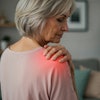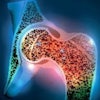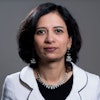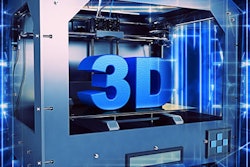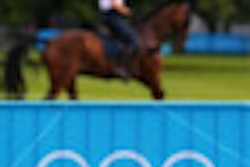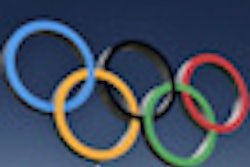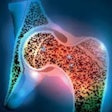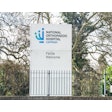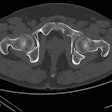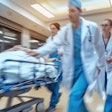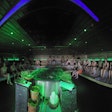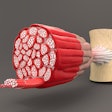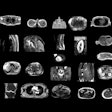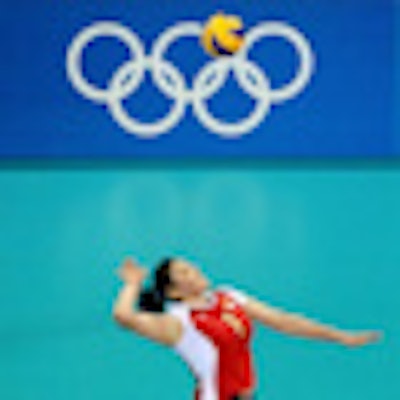
The elite squad of more than 100 volunteers charged with the task of imaging the Olympics came together for the first time last week in London. Less than six weeks before the games begin, the group received training on the wide range of equipment in the new 5,000-square-meter four-story polyclinic building, which opened officially yesterday.
 Ready for action: Alison Tuck, CT clinical specialist radiographer from Kingston Hospital, U.K., proudly models the purple shirt to be worn by all polyclinic staff during the games. Medical staff won't wear white coats.
Ready for action: Alison Tuck, CT clinical specialist radiographer from Kingston Hospital, U.K., proudly models the purple shirt to be worn by all polyclinic staff during the games. Medical staff won't wear white coats.
"It was really nice to see everybody's faces and to show that we really do exist," said Carole Burnett, lead radiographer for London 2012. "Most people haven't used these exact machines before, so there's a lot for them to learn before we begin for real on 27 July. Everybody has to commit to at least 10 days' work, plus three days of mandatory training."
The organizers have spent an estimated 7 million pounds (8.7 million euros) on imaging equipment from GE Healthcare, including a Discovery MR750w wide-bore 3-tesla MRI system, an Optima MR450w wide-bore 1.5-tesla MRI unit, a Discovery 750HD CT scanner, which are located in temporary buildings in front of the main entrance to the polyclinic. Other equipment includes a Discovery XR656 wireless digital x-ray system, and Venue 40 and Logiq E9 ultrasound systems.
A total of 27 radiologists, 56 radiographers, and 23 radiographic assistants have been recruited by Burnett and consultant musculoskeletal radiologist Dr. Phil O'Connor, who are colleagues at Chapel Allerton Hospital in Leeds, U.K. Of this team, 81 met last Thursday at Hackney Community College, where they heard talks from LOCOG (London Organizing Committee of the Olympic and Paralympic Games) staff, as well as a joint presentation by O'Connor and Burnett. This was followed by onsite, hands-on training from GE's team of applications specialists.
 Dylan Pritchard (right), MRI clinical education leader EMEA at GE Healthcare, conducts a training session in the Olympics polyclinic on the Discovery MR750w wide-bore 3-tesla MRI system.
Dylan Pritchard (right), MRI clinical education leader EMEA at GE Healthcare, conducts a training session in the Olympics polyclinic on the Discovery MR750w wide-bore 3-tesla MRI system.
All staff must be registered with the Health Professions Council, an independent, U.K.-wide regulatory body responsible for setting and maintaining standards of professional training. The radiologists and radiographers come from across the U.K., and range in age from their early 20s to 60 and older, noted Burnett, who has tried to build team spirit among the radiographers over the past few months by distributing a personal email newsletter.
Over the coming weeks, Burnett is taking a break from her research post at Chapel Allerton, where she works as a fellow funded by the National Institute for Health Research. She is in the second year of her four-year doctoral program, focusing on imaging of spondylitis without gadolinium.
During the Olympics, volunteers get free travel on public transport in London, but they receive no tickets and must even cover the cost of their own accommodation. Most radiologists and radiographers will be staying in an accommodation block at St. Bartholomew's Hospital, about a 15-minute walk from the Olympic Village. Each room will cost 17 pounds (about 21 euros) a day. Also, most medical staff working in the U.K. National Health Service (NHS) will have to use part of their annual holiday entitlement to work at the games because it is at the discretion of individual hospital trusts, or groups, as to whether an NHS employee will receive paid, professional leave.
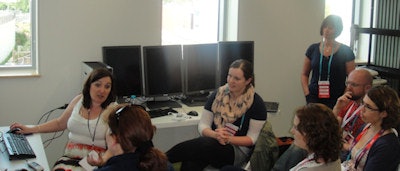 Before the start of the games, all radiologists and radiographers must learn how to use GE Healthcare IT's Centricity RIS/PACS, which will store the patient's imaging records and make available the complete electronic record. The PACS trainers for the Olympics are Sarah Kay and Tracy Finlayson, healthcare IT applications specialists from GE Healthcare.
Before the start of the games, all radiologists and radiographers must learn how to use GE Healthcare IT's Centricity RIS/PACS, which will store the patient's imaging records and make available the complete electronic record. The PACS trainers for the Olympics are Sarah Kay and Tracy Finlayson, healthcare IT applications specialists from GE Healthcare.At the end of games, the polyclinic will become a GP surgery for residents living in the surrounding area, including the occupants of the 10,000 or so apartments built for the athletes and coaches. The imaging equipment is likely to be sold or redeployed within the NHS.
Editor's note: Look for the next installment of AuntMinnieEurope.com's comprehensive coverage of the 2102 Olympics, which will look at the logistical aspects of setting up the polyclinic. It will feature an interview with Finn Crotty, head of Olympic delivery at GE Healthcare.
|
Polyclinic fact file
|

